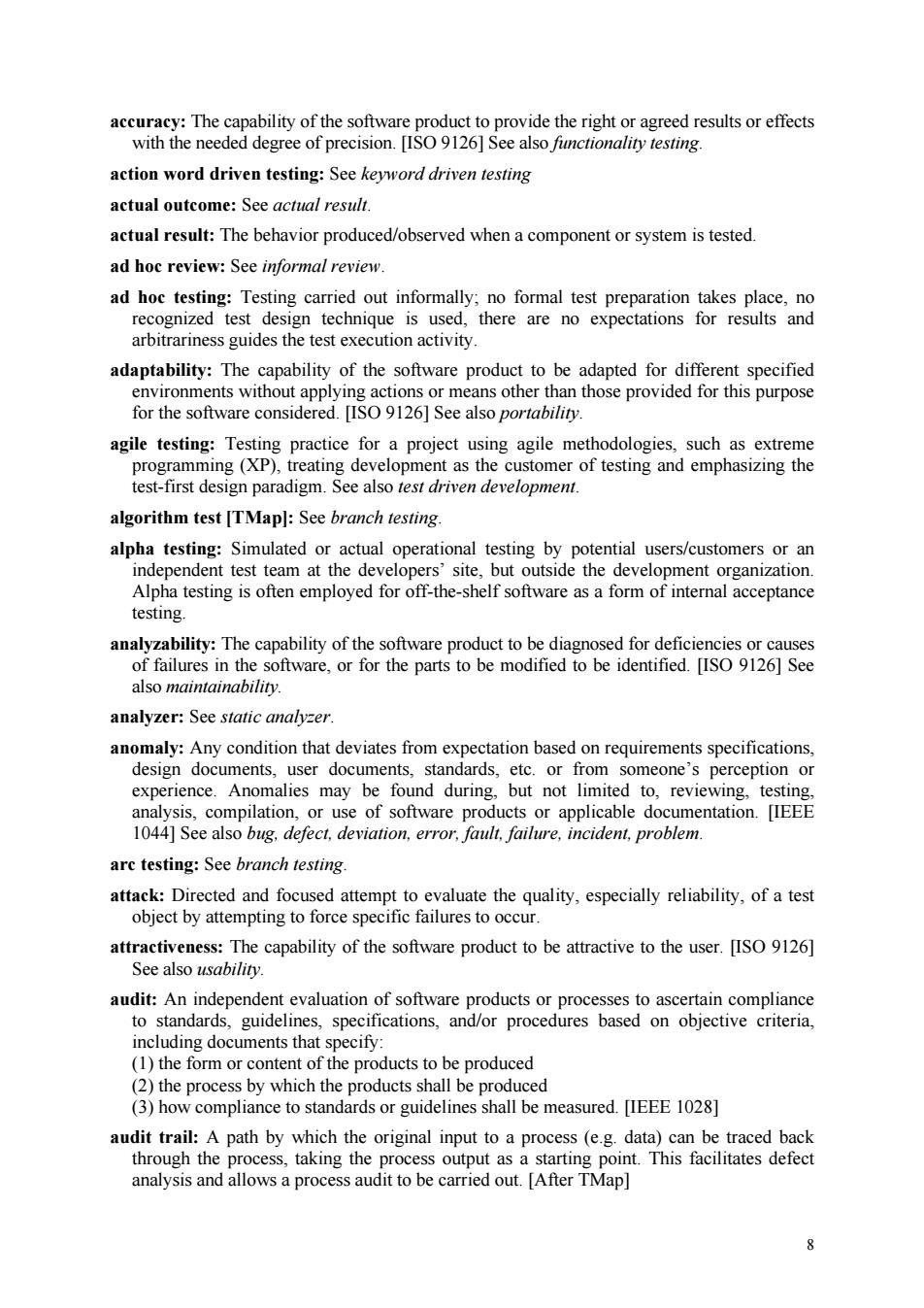正在加载图片...

accuracy:The capability of the software product to provide the right or agreed results or effects with the needed degree of precision.IISO 9126]See also functionaliry testing. action word driven testing:See keyword driven testing actual outcome:See actual resul actual result:The behavior produced/observed when a component or system is tested ad hoc review:See informal review. ad hoc testing:Testing carried out informally;no formal test preparation takes place,no design technique is used,there are no expectations for results and arbitrariness guides the test execution activity. dabitth han those proi vided for thi is purpose for the software considered.[ISO9126]See also portability. agile testing:Testing practice for a project using agile methodologies,such as extreme programming(XP),treating development as the customer of testing and emphasizing the test-first design paradigm.See also test driven development algorithm test [TMapl:See branch testing. tes utsid pot ers/ ners an at the Alpha testing is often mployed for off-the-shelf software as a form of nterna cceptanc testing. analyzability:The capability of the software product to be diagnosed for deficiencies or causes of failures in the software.or for the parts to be modified to be identified.nIso 91261 See also maintainability. analyzer:See static analyzer. anomaly:Any ndition that deviates from tation hased on design do ser docume standards te.or from ne's ion or experience.Anomalies may be found during but not li ited to reviewing analysis,compilation,or use of software products or applicable documentation 1044]See also bug,defect,deviation,error,fault,failure,incident,problem. are testing:See branch testing. attack:Directed and focused attempt to evaluate the quality,especially reliability,of a test object by attempting to force specific failures to occur The capbility of thr product t be altractive to the user.6 usability audit:An independent evaluation of software products or processes to ascertain compliance to standards,guidelines,specifications,and/or procedures based on objective criteria, including documents that specitv (1)the form or content of the products to be produced (2)the process by which the products shall be produced (3)how compliance to standards or guidelines shall be measured.[IEEE 1028] :A path by which t to a pro ta de a proce8 accuracy: The capability of the software product to provide the right or agreed results or effects with the needed degree of precision. [ISO 9126] See also functionality testing. action word driven testing: See keyword driven testing actual outcome: See actual result. actual result: The behavior produced/observed when a component or system is tested. ad hoc review: See informal review. ad hoc testing: Testing carried out informally; no formal test preparation takes place, no recognized test design technique is used, there are no expectations for results and arbitrariness guides the test execution activity. adaptability: The capability of the software product to be adapted for different specified environments without applying actions or means other than those provided for this purpose for the software considered. [ISO 9126] See also portability. agile testing: Testing practice for a project using agile methodologies, such as extreme programming (XP), treating development as the customer of testing and emphasizing the test-first design paradigm. See also test driven development. algorithm test [TMap]: See branch testing. alpha testing: Simulated or actual operational testing by potential users/customers or an independent test team at the developers’ site, but outside the development organization. Alpha testing is often employed for off-the-shelf software as a form of internal acceptance testing. analyzability: The capability of the software product to be diagnosed for deficiencies or causes of failures in the software, or for the parts to be modified to be identified. [ISO 9126] See also maintainability. analyzer: See static analyzer. anomaly: Any condition that deviates from expectation based on requirements specifications, design documents, user documents, standards, etc. or from someone’s perception or experience. Anomalies may be found during, but not limited to, reviewing, testing, analysis, compilation, or use of software products or applicable documentation. [IEEE 1044] See also bug, defect, deviation, error, fault, failure, incident, problem. arc testing: See branch testing. attack: Directed and focused attempt to evaluate the quality, especially reliability, of a test object by attempting to force specific failures to occur. attractiveness: The capability of the software product to be attractive to the user. [ISO 9126] See also usability. audit: An independent evaluation of software products or processes to ascertain compliance to standards, guidelines, specifications, and/or procedures based on objective criteria, including documents that specify: (1) the form or content of the products to be produced (2) the process by which the products shall be produced (3) how compliance to standards or guidelines shall be measured. [IEEE 1028] audit trail: A path by which the original input to a process (e.g. data) can be traced back through the process, taking the process output as a starting point. This facilitates defect analysis and allows a process audit to be carried out. [After TMap]